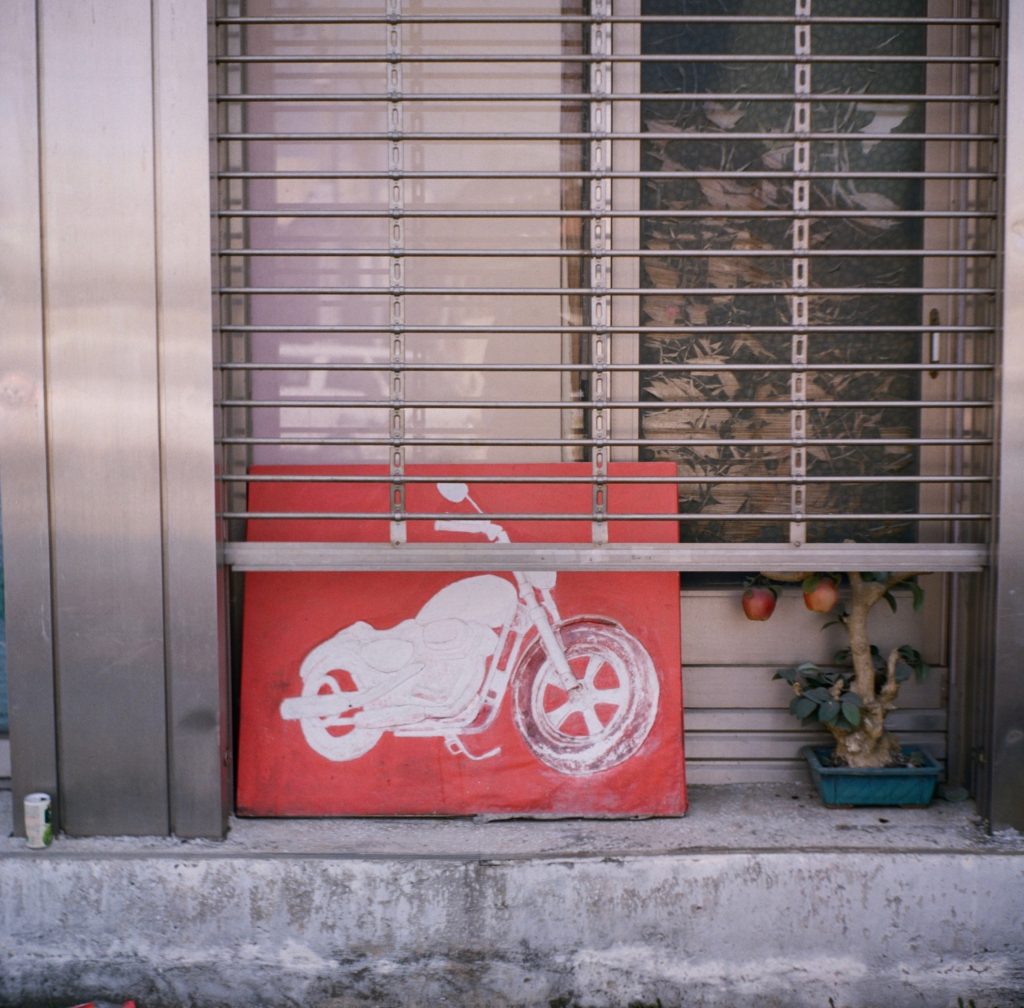Gwangju’s Orphaned Art
Written and photographed by Ryan Berkebile
As I stroll through a residential street in downtown Gwangju, I notice someone’s unfinished painting of a motorcycle. One tire has been painted in, but has begun to fade because of exposure to the elements. The rest of the motorcycle remains in outline, ready for anyone who passes by to complete the work of art. The incomplete canvas leans against a shuttered entrance next to a fake apple tree. This modern still life is an anomaly on my walks through the City of Light. On my jaunts, I usually come upon traditional Korean landscape paintings, ink renderings of the Indian monk Bodhidharma (달마), or colorful tributes to Buddhist Bodhisattvas left for the trash collectors. Sometimes I luck out and find folding screens with panoramic floral scenes on one side and hanja (Chinese characters) on the flip side. Seeing these magnificent works always arouses questions and theories about the causes of orphaned art.

Besides the intense drive to modernize and move on, why do people leave their personal belongings behind? One plausible explanation for this phenomenon is rooted in Korean folklore. As the superstition goes, evil spirits will follow families moving to a new home if they aren’t conned into believing otherwise. How do you fool the incorporeal beings? Families leave behind material possessions, which deceives the ghosts into believing they haven’t departed for a new abode. This would explain why I’ve seen many abandoned households full of pictures of important events, like weddings or births. The pictures are a sacrifice – an act of appeasement in order for the family and the spirits to move on. Moving companies consult with families about which days are considered safe to move. These days are called son eopneun nal (손 없는 날), which literally means “damage/loss-free day” (i.e., a day that the evil spirits are at rest).

For the non-superstitious, I suspect ghosts don’t cause distress as much as the feeling of being overwhelmed by possessions. In the course of living on this planet, we are constantly reevaluating and reconstructing the story of our “I.” Our material possessions reflect our former hobbies, fashions, and attitudes. Outgrown personal effects are put into our closets and forgotten about. It’s tricky to maintain a sensible balance between clutter and useful goods. It becomes difficult to be honest with ourselves whether we’ll ever use those skis or listen to those Steely Dan records again. The easy answer is to put off a definite answer and save it “just in case.” For people in stable living situations, stuff can pile up for decades, making it increasingly hard to differentiate the memories with the objects themselves. Come moving day, maybe leaving many of these things behind brings an unintentional sense of relief for packrats.

A few years ago in the Yang-dong neighborhood, a couple of friends presented their discovery of a forgotten hanok (traditional Korean house) that was someone’s art space. You could sense the history through the mud walls and thatched ceiling. It was probably built during Park Chung-hee’s reign. In the living space, we came across brushes, carving tools, and canvasses in various stages of completion piled up in the residence. We learned the artist’s name through scattered photographs and accolades, and constructed a story about his life as an artist. From the stacks of canvas in the house, we could see the artist felt compelled to paint impressionistic landscape scenes. Within vivid, colorful scenes of mountains and streams, he included scenes of human life. Tiny houses and small cart paths of the human world complimented the striking beauty of nature. Stumbling upon these scenes intensified my awareness of orphaned art in Gwangju.

Many things qualify as orphaned art. For example, art intended for outdoor display can even be considered orphaned. Sculptures originally intended to beautify and harmonize with nature are often left behind to fight a battle against unmanicured flora. During the spring, I visited a recently closed university campus and came across lifelike clay renderings of humans in what was once a shady, forested area. These works of art were so realistic that I was initially startled by them. I thought I’d come across a bunch of friends who were mourning the loss of their school. Upon further inspection, a male and two female cohorts appeared to have been having a deep existential conversation about the meaning of life. Off to the side, two uprooted figures that had been partially damaged from the move laid in eternal rest. Maybe the trio engaged in philosophical conversation were contemplating their fate as castaways.
Perhaps the most surprising place I spotted orphaned art at was in an unused greenhouse near Mudeung Mountain. My traveling companion and I were aimlessly wandering around, as is our wont. Curiosity took over after we spied said greenhouse being taken over by nature. Any structure overgrown with flora gets us excited about the possibilities of what lies inside. On this particular day, we found numerous works of art, including muddy, water-logged calligraphy of hanja (한자, Chinese characters) and a portrait of Guan Yin Bodhisattva (관세음보살) still looking bright and serene despite the elements taking their toll. Why they were put there is anyone’s guess, but maybe the previous owners felt an ease of burden in doing so. Maybe Guan Yin’s relaxed expression mirrors the owners’ newfound freedom from anxiety over their possessions.
The Author
Ryan Berkebile is an English teacher, analog camera fanatic, and urban explorer living in Gwangju. He has been teaching in Korea since 2005 with brief stops in Vietnam and Japan along the way. Visit longdistancerunner.org or @zen_compass to see photos of his explorations.




